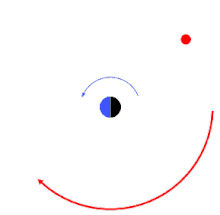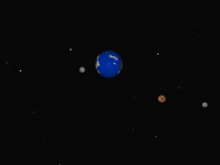From Wikipedia, the free encyclopedia
This
article is about retrograde motions of celestial bodies relative to a
gravitationally central object. For the apparent motion as seen from a
particular vantage point, see Apparent retrograde motion.
In the Solar System, all the planets and almost all of the other objects that revolve in orbit around the Sun, with the exception of many comets, do so in the "prograde" direction, i.e the same sense as the rotation of the Sun. Most planets also rotate in the same prograde direction, the exceptions being Venus and Uranus, which have retrograde rotations. Most satellites of planets also revolve around their planets in the prograde sense. (In the case of the satellites of Uranus, this means they revolve in the same sense as Uranus's rotation, which is retrograde relative to the Sun.) There are some satellites which revolve in the retrograde sense, but these are generally small and distant from their planets, except for Neptune's satellite Triton, which is large and close. It is thought that these retrograde satellites, including Triton, are bodies which have been captured into orbit around their planets, having been formed elsewhere.
Contents |
Formation of celestial systems
When a galaxy or a planetary system forms, its material takes the shape of a disk. Most of the material orbits and rotates in one direction. This uniformity of motion is due to the collapse of a gas cloud.[1] The nature of the collapse is explained by the principle called conservation of angular momentum. In 2010 the discovery of several hot jupiters with backward orbits called into question the theories about the formation of planetary systems.[2] This can be explained by noting that stars and their planets do not form in isolation but in star clusters and when the protoplanetary disk from one star collides with or steals material from another star's disk this can result in retrograde motion of a disk and the resulting planets.[3][4]Orbital parameters
Inclination
A celestial object's inclination indicates whether the object's orbit is prograde or retrograde. The inclination of a celestial object is the angle between its orbital plane and another reference frame such as the equatorial plane of the object's primary. In the Solar System, inclination of the planets is measured from the ecliptic plane, which is the plane of Earth's orbit around the Sun.[5] The inclination of moons is measured from the equator of the planet they orbit. An object with an inclination between −90 and +90 degrees is orbiting or revolving in the same direction as the primary is rotating. An object with an inclination of exactly 90 degrees has a perpendicular orbit which is neither prograde nor retrograde. An object with an inclination between 90 degrees and 270 degrees is in a retrograde orbit.Axial tilt
A celestial object's axial tilt indicates whether the object's rotation is prograde or retrograde. Axial tilt is the angle between an object's rotation axis and a line perpendicular to its orbital plane passing through the object's centre. An object with an axial tilt up to 90 degrees is rotating in the same direction as its primary. An object with an axial tilt of exactly 90 degrees has a perpendicular rotation which is neither prograde nor retrograde. An object with an axial tilt between 90 degrees and 270 degrees is rotating in the opposite direction to its orbital direction.Earth and the planets
All eight planets in the Solar System orbit the Sun in the direction that the Sun is rotating, which is counterclockwise when viewed from above the Sun's north pole. Six of the planets also rotate about their axis in this same direction. The exceptions—the planets with retrograde rotation—are Venus and Uranus. Venus's axial tilt is 177 degrees, which means it is spinning almost exactly in the opposite direction to its orbit. Uranus has an axial tilt of 97.77 degrees, so its axis of rotation is approximately parallel with the plane of the Solar System.Within the atmosphere
Retrograde motion, or retrogression, within the Earth's atmosphere refers to weather systems which move from east to west through the Westerlies or from west to east through the Trade wind easterlies.Moons and rings
If formed in the gravity-field of a planet as the planet is forming, a moon will orbit the planet in the same direction as the planet is rotating and is a regular moon. If an object is formed elsewhere and later captured into orbit by a planet's gravity, it can be captured into a retrograde or prograde orbit depending on whether it first approaches the side of the planet that is rotating towards or away from it. This is an irregular moon.[6]In the Solar System, many of the asteroid-sized moons have retrograde orbits, whereas all the large moons except Triton (the largest of Neptune's moons) have prograde orbits.[7] The particles in Saturn's Phoebe ring are thought to have a retrograde orbit because they originate from the irregular moon Phoebe.
All retrograde satellites experience tidal deceleration to some degree. The only satellite in the Solar System for which this effect is non-negligible is Neptune's moon Triton. All the other retrograde satellites are on distant orbits and tidal forces between them and the planet are negligible.
Within the Hill sphere, the region of stability for retrograde orbits at a large distance from the primary is larger than that for prograde orbits. This has been suggested as an explanation for the preponderance of retrograde moons around Jupiter. Because Saturn has a more even mix of retrograde/prograde moons, however, the underlying causes appear to be more complex.[8]
Asteroids, comets, and Kuiper belt objects
Asteroids usually have a prograde orbit. By February 2011, astronomers have identified a mere 36 asteroids in retrograde orbits. The retrograde asteroids may be burnt-out comets.[9]Comets from the Oort cloud are much more likely than asteroids to be retrograde.[9] Halley's Comet has a retrograde orbit around the Sun.[10]
The first Kuiper belt object discovered to have a retrograde orbit is 2008 KV42.[11] The dwarf planet Pluto has retrograde rotation, not orbit. Pluto's axial tilt is approximately 120 degrees.[12]
The Sun
The Sun's motion about the centre of mass of the Solar System is complicated by perturbations from the planets. Every few hundred years this motion switches between prograde and retrograde.[13]Exoplanets
Stars and planetary systems tend to be born in star clusters rather than forming in isolation, so one protoplanetary disk can collide with another or with dense gas clouds and this can lead to disks and their resulting planets having inclined or retrograde orbits around their stars.[3][4]Retrograde motion may also result from gravitational interactions with other celestial bodies in the same system (See Kozai mechanism.) or a near-collision with another planet,[14] or it may be that the star itself flipped over early in their system's formation due to interactions between the star's magnetic field and the planet-forming disk.[15][16]
In one study more than half of all the known hot Jupiters had orbits that were misaligned with the rotation axis of their parent stars, with six having backwards orbits.[2]
WASP-17b was the first exoplanet that was discovered to be orbiting its star opposite to the direction the star is rotating.[17] A second such planet was announced just a day later: HAT-P-7b.[18]
Stars
The pattern of stars appears fixed in the sky, but that is only because they are so far away that their motion isn't visible to the naked eye; actually, they are orbiting the centre of the galaxy. Stars with a retrograde orbit are more likely to be found in the galactic halo than in the galactic disk. The Milky Way's outer halo has many globular clusters with a retrograde orbit[19] and with a retrograde or zero rotation.[20] The halo consists of two distinct components. The stars in the inner halo mostly have prograde orbits around the galaxy, whereas stars in the outer halo typically have retrograde orbits.[21]The nearby Kapteyn's Star is thought to have ended up with its high-velocity retrograde orbit around the galaxy as a result of being ripped from a dwarf galaxy that merged with the Milky Way.[22]
Galaxies
Satellite galaxies
Close-flybys and mergers of galaxies within galaxy clusters can pull material out of galaxies and create small satellite galaxies in either prograde or retrograde orbits around larger galaxies.[23]A galaxy called Complex H, which was orbiting the Milky Way in a retrograde direction relative to the Milky Way's rotation, is colliding with the Milky Way.[24][25]


No comments:
Post a Comment